Abstract
The use of wireless communications systems on the factory shop floor is becoming an appealing solution with many advantages compared to cable-based solutions, including low cost, easy deployment, and flexibility. This, combined with the continuous growth of low-cost mobile devices, creates opportunities to develop innovative and powerful applications that, in many cases, rely on computing and memory-intensive algorithms and low-latency requirements. However, as the density of connected wireless devices increases, the spectral noise density rises, and, consequently, the radio interference between radio devices increase. In this paper, we discuss how the density of AR/VR mobile applications with high throughput and low latency affect industrial environments where other wireless devices use the same frequency channel. We also discuss how the growing number of these applications may have an impact on the radio interference of wireless networks. We present an agnostic methodology to assess the radio interferences between wireless communication systems on the factory floor by using appropriate radio and system models. Several interference scenarios are simulated between commonly used radio systems: Bluetooth, Wi-Fi, and WirelessHART, using SEAMCAT. For a 1% probability of interference and considering a criterion of C/I = 14 dB, the simulations on an 80 m × 80 m factory shop floor show that low-bandwidth systems, such as Bluetooth and WirelessHART, can coexist with high-bandwidth and low-latency AR/VR applications running on Wi-Fi mobile terminals if the number of 11 Wi-Fi access points and 80 mobile AR/VR devices transmitting simultaneously is not exceeded.
1. Introduction
Mobile augmented reality (AR) and mobile virtual reality (VR) are gaining considerable attention mainly because of the wide adoption of mobile and wearable devices. The continuous growth of low-cost mobile devices with greater mobility and augmented by edge computing has created new opportunities, and these devices have considerable potential for promoting a wide range of industrial applications. However, these applications often rely on computing and memory-intensive algorithms with high data rates and low-latency requirements. They are going to create significant growth in network traffic, and they have demanding requirements in terms of storage, rendering capability, and internet connectivity, and it is common to offload data processing to a distant but more powerful device, i.e., offloading computation. In contrast, the characteristics of this type of application, and the fact that they are more oriented to use a certain type of wireless communication, may also influence the interference in other radio systems in use in the same environment. This process introduces new constraints, particularly in terms of interference, latency, and bandwidth.
This is particularly aggravated in scenarios with a high density of devices connected by wireless networks, such as industrial shop floors. Even if during the last three decades, industry has implemented automation in all production processes on the factory shop floor by using wired systems, some important processes are not easily connected through wired systems. The integration of logistics, material handling, mobile industrial robots (AGV), and AR/VR devices can only be effective with the use of wireless systems. With the advent of Industry 4.0, industrial production suffered a total transformation through the combination of embedded systems, communication devices, and the Internet of things (IoT) technologies with the legacy industry systems, causing all processes on the factory shop floor, fixed or mobile, to be interconnected with digital networks. Therefore, nowadays, wireless technologies are commonly found on the industrial shop floor [1], and we may witness a swarm of wireless devices being used for different scenarios in industrial production and maintenance. In this context, mobile AR/VR applications have aroused considerable attention and have been a persistently trending topic among academia and industry. As a result, numerous innovative applications have emerged with significant impacts on the organization and efficiency of companies. Some examples include guided maintenance and operations (e.g., [2,3]), remote collaboration (e.g., [4,5]), and training (e.g., [6,7]). However, these applications require high-capacity and reliable memory, computational and storage resources, and significant bandwidth and latency requirements. Considering this, and because wireless systems are increasingly predominant, becoming increasingly present in mission-critical or massive machine-type communication applications, spectrum compatibility studies are essential to assess the coexistence between them. Wi-Fi is still currently the most widespread wireless technology in industrial production [8], with a global share higher than 74% of the inquiries, seconded by Bluetooth (39%) and followed by other wireless communication systems such as WirelessHART (13%). All of these wireless technologies share the same industrial, scientific, and medical (ISM) bands. Using license-exempt frequency bands has many advantages. Wireless communications systems can be easily deployed without the burden of a license cost for spectrum use [9] which eliminates the physical barriers of conventional wired communication architectures at a reduced cost and low maintenance. However, wireless systems using ISM bands have several drawbacks. There is a legal limit to the power level of the emitted radiation. Furthermore, radio interference management in ISM bands is not only challenging because of the noise power level and dense usage but also because of the different standards operating concurrently [10]. A recent study using simulated scenarios found that systems using Wi-Fi, Bluetooth, or WirelessHART technologies are more prone to suffer interference from other systems working in co-channel arrangements [11]. However, the study focuses only on the downlink (access points) and does not discriminate the importance of the density of new mobile devices (e.g., Wi-Fi and Bluetooth), transmitting at a lower height on the shop floor on the uplink. As such, with an ever-increasing number of wireless devices operating on the shop floor, using the same frequency band but working with different technologies, there is a need for further studies on the limits of the density of wireless devices that can share radio resources within the limits of the Quality of Service (QoS) for the system to operate correctly. We used the spectrum engineering advanced Monte Carlo analysis tool (SEAMCAT) software [12], from the European Communication Office of the European Conference of Postal and Telecommunications Administrations (CEPT), to assess the spectral interference between different types of wireless systems. SEAMCAT uses a Monte Carlo analysis in contrast to conventional analytical methods which are typically applied to ordinary or partial differential equations that describe some underlying physical or mathematical systems. A Monte Carlo simulation requires that the physical or mathematical system be described by probability density functions (pdfs) and then proceeds by a random sampling of them. These pdfs can represent the location of the interferers with respect to the victim, transmitted power, attenuation variations over time of the victim, and interferer propagation channels, among many others. Many simulation trials are performed and the desired result is taken as an average over the number of observations [13]. When a sufficient number of simulation trials are considered, the probability of a certain event occurring can then be evaluated. Thus, this approach is technologically agnostic and can combine, in a single scenario, different wireless systems technologies such as Wi-Fi, WirelessHART, and Bluetooth.
1.1. Contributions of the Study
Because of the lack of previously published studies on the limits of the density of wireless devices that can share radio resources on the shop floor, combined with the new demands in this environment (where AR/VR applications are more frequently used in Industry 4.0 scenarios), we present a study to overcome this research gap. This paper contributes to a study that analyzes the interference between wireless networks in those environments and the impact that the use of AR/VR applications that intensively use Wi-Fi may have on other radio systems using the same frequency bands.
The objective of this paper is twofold:
- First, to investigate how the density of wireless devices, which can be deployed in a confined industrial environment, can interfere with the interaction experience of users in mobile applications, particularly those with computational and memory-intensive requirements which are more demanding in terms of bandwidth and latency.
- Second, to discuss how the growing number of mobile AR/VR applications may affect the radio interference of different types of wireless networks that coexist in the same industrial environment.
To this end, this work analyzes the interference scenario simulations from [11], by discriminating the downlink from the uplink systems at the configuration stage by using adequate propagation models for Wi-Fi, WirelessHART, and Bluetooth, and assesses the density of wireless devices that can be deployed in a confined environment, such as a factory shop floor, within the allowable interference limit.
1.2. Paper Structure
The remainder of this article is organized as follows. Section 2 provides the challenges, background, and an analysis of the previous related works. Section 3 provides an outline of the methodology used for interference simulations. Section 4 presents the properties of the wireless system, including transmitter and receiver specifications. Section 5 describes the radio interference scenarios. Section 6 discusses and highlights the findings of the simulation results. Finally, Section 7 presents the conclusions and future work.
2. Challenges and Related Work
This section briefly presents some of the main challenges that must be faced to achieve clear interaction and long battery life in mobile devices for computing and memory-intensive applications, such as AR/VR. It also presents a brief analysis of some related works that studied the influence that wireless network technologies may have on the interactivity of these types of mobile applications.
2.1. Challenges
Mobile app users want clear interaction and long battery life. Achieving these attributes on small, lightweight mobile devices for computing and memory-intensive applications such as AR/VR, image recognition, or artificial intelligence applications, poses major challenges. Some of these challenges have already been identified and studied by several authors, namely:
- Computing efficiency—Mobile AR/VR applications are computation and data-intensive applications. Thus, the computational and rendering abilities of mobile devices play an important role in the improvement of the performance of mobile AR applications. However, current mobile devices present an inefficient runtime environment because of their limited computational and storage abilities, and this may lead to very low frames per second (FPS) [14,15,16].
- Network communication efficiency. Because of the limited computing efficiency and limited battery capacity of mobile devices, offloading the tasks to a remote server is a common practice. This requires sufficient bandwidth and incurs additional delays during the interactions and may influence the user experience, as the latency caused by the communication with the remote servers must have very low values to be imperceptible to the user [14,15,16,17]. In addition, sending more data on the uplink (from the mobile device to a remote server) than receiving it on the downlink may cause some performance issues for other connections sharing the same asymmetric bottleneck [18].
- Energy consumption/efficiency—Mobile AR/VR applications are highly power-consuming tasks with a significant impact on the battery in mobile devices [14,17].
- Compatibility and standardization—It is important to build technology-independent mobile AR/VR services (hardware-independent, browser-independent, producer-independent) using standardized technologies [14,15]. However, achieving this poses several challenges [15]: mobile hardware has different levels of support for AR; there is no standardization of techniques to define the common protocols and application programming interfaces (APIs) to simplify the deployment; and modern web browsers and built-in browsers have very different capabilities to support AR applications and lack a standard for web 3D objects.
- Privacy and Security—AR/VR mobile applications may collect more personal information (such as personal identification or location information) than traditional systems, and this can impact user privacy. Therefore, mechanisms for data generation and mechanisms of data access, as well as a secure network environment for data transmission, are required [14]. However, a trade-off needs to be found between the user’s privacy and the amount of personal data required for the appropriate behavior of the application [18].
- Application Deployment—The demand for mobile AR/VR applications is high, but there are still many limitations. As more open-source software and more development platforms and educational programs for AR are made publicly available, more AR applications will emerge [14].
Among the challenges listed, the last two (privacy and security, and application deployment) are not related to the focus of this work, so this article will only address some aspects relating to the first four challenges (computing efficiency, network communication efficiency, energy consumption/efficiency, and compatibility and standardization).
2.2. Related Work
This subsection covers two broad areas related to the work described in this article:
- Research that analyzes the influence of wireless network efficiency on mobile AR applications and possible solutions to face the challenges encountered;
- Research on radio interference analysis of wireless networks in industrial environments.
Several works have studied the influence that wireless network technologies have on the interactivity of mobile applications. A study described in [17], attempts to answer the question of whether it is feasible to enable cloud-based mobile AR with an acceptable quality of experience (QoE). They investigated the cloud offloading features of some commercial software development kits (SDKs), and they measured the time consumed by each component in the pipeline on both mobile devices and servers. Devices were connected using Wi-Fi. They analyzed the end-to-end latency, data usage, and energy consumption on mobile devices. They found that cloud-based recognition is still not mature and not optimized for latency, data usage, and energy consumption. In ref. [19], the authors explore how computational offloading services at the edge of the Internet for mobile devices improve latency and energy consumption. They present experimental results from Wi-Fi and 4G Long Term Evolution (LTE) networks that confirm substantial wins from edge computing for highly interactive mobile applications. They also found that, in deeply immersive applications, such as mobile augmented reality and cognitive assistance, the industrial efforts toward building edge computing infrastructure could be key enablers of this new genre of applications. These studies indicate that cloud-based mobile AR applications affect latency, data usage, and energy consumption and that they have an impact on the user interaction experience with these applications. They also suggest that there are substantial gains from using edge computing for mobile AR applications.
Spectrum sharing of the 2.4 GHz ISM band and the resulting interference between different communication systems has been a topic of study in the past. In ref. [20], SEAMCAT was used for the interference simulation between WLAN and Bluetooth in urban scenarios, with the Wi-Fi system as a victim link and Bluetooth as an interfering link. In [21,22], another compatibility study was conducted between WirelessHART systems as victim links and Wi-Fi as the interfering system, and in [23], an experimental study between Bluetooth and Wi-Fi is reported. However, the conclusion that all systems can coexist with each other over a certain QoS is drawn when Bluetooth and WirelessHART systems can avoid the occupied Wi-Fi channels. However, as far as the authors are aware, no study has been conducted considering the full occupation of the spectrum in an industrial shop floor by using a high density of radio transmitters. Another study [24] presents some experimental results (using the ORBIT radio grid testbed) to quantify the effects of inter- and intra-radio interference in a small office and home scenarios. They emulate different topologies, traffic loads, and numbers of interfering devices to show the impact of multi-radio interference and to characterize each type of interference. They present some common scenarios such as slow link–fast link interference in 802.11, co-located Bluetooth and 802.11 radios, and dense deployment of both Bluetooth and ZigBee radios, and benchmark the loss of the usable throughput in each case. The experimental results outline the impact of the inter-radio interference and show that in typical topologies, the effect of one radio class on the others causes significant reductions in throughput. Although the study considers a different environment and different wireless network technologies, it allows some conclusions about the effect of radio interference. Other studies have proposed adaptive frequency-hopping techniques or scanning, evaluating, and avoiding noisy channels for Bluetooth and WirelessHART systems to mitigate these performance degradation issues of coexisting networks with Wi-Fi, but in densely used radio environments, this solution may not satisfy the minimum requirements for reliable communication [25]. Authors in [26] argue that there is a gap in terms of future work for making wireless networks reliable by considering the effects of interference in several environments.
With the consideration of an industrial environment, the communication requirement is focused on multiple factors such as reliability, latency, the longevity of communicating devices, and throughput, a traditional focus of human-centric wireless communication systems [27]. The authors in [28] experimentally verified the inverse relationship between latency and signal-to-interference-plus-noise ratio (SINR) and the direct relationship between latency and the number of radio transmitters. As such, noisy and crowded radio environments, where many different devices communicating using different wireless technologies often coexist, may pose a real challenge for high-performance mobile AR/VR applications. As such, there is a lack of studies that analyze the interference between the various wireless networks in an industrial environment and that simultaneously address the impact of the use of AR/VR applications that make intensive use of Wi-Fi communication in these same environments. Next, the methodology to analyze the interference between the various wireless networks in an industrial environment is presented.
3. Methodology
SEAMCAT is an open-source software tool for a statistical simulation model that uses a technique of analysis called Monte Carlo to evaluate the possible intrusion between different radio communication networks [12]. The typical simulation flow is depicted in Figure 1.
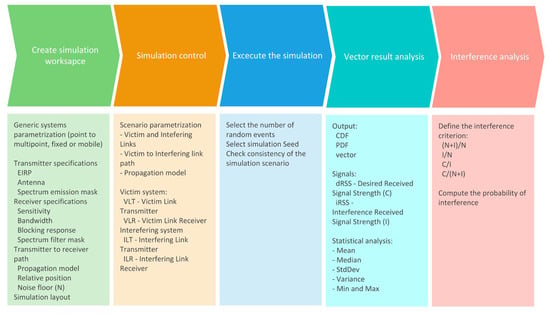
Figure 1.
Simulation workflow in SEAMCAT.
As shown in Figure 2, the simulation scenario consists of one or more interfering links and one victim link.

Figure 2.
Schematic compatibility scenario and terminology used in SEAMCAT for the primary (victim) and secondary (interferer) links.
The main interference mechanisms that can be analyzed in SEAMCAT are the unwanted emissions of interfering transmitters, the selectivity and overloading of the victim system receiver, and the effect of the intermodulation products. Figure 3 depicts the two main interference mechanisms typically analyzed (i.e., unwanted emissions and receiver selectivity).

Figure 3.
Unwanted emissions and receiver selectivity.
A commonly accepted criterion for interference studies is based on the I/N ratio. The interference-to-noise ratio, I/N, should be less than the minimum allowable value of −6 dB [29]. According to Recommendation ITU-R F.1094 [30], this is the relevant interference protection criteria for the long-term interference objective (20% of the time) in the frequency band from 30 MHz to 3 GHz. For the complementary analysis, an additional protection criterion, C/I = 14 dB, was considered, which corresponds to an adequate value for the wireless service in the 2.4 GHz frequency band to operate with the minimum QoS requirements [31]. This criterion was derived from [29].
To compute the I/N (C/I) of the radio receiver from the victim link where interference occurs, we first need to determine the wanted signal from the corresponding radio transmitter, called C, the background noise (including thermal noise), called N, and the signal produced by the interfering transmitter(s), called I. This is done by defining the technical specifications for each radio receiver and transmitter of the interfering and victim links, the radio propagation model, and other parameters related to the quality of service required. The position of each transmitter and receiver is set (fixed or mobile), and a link budget is calculated. With the knowledge of both the interfering signal and the victim signal, the I/N (C/I) ratio at the receiver of the victim link is computed using a Monte Carlo method.
After all of the radio systems are configured, the software runs a series of trials or events. For each trial, the received signal C is compared to the sensitivity S of the victim link receiver. If C is lower than S, the event is discarded. Then, if I/Ntrial (C/Itrial) is higher than I/Ntarget (C/Itarget), no interference is recorded; otherwise, interference arises, and this trial accumulates to the other events with the same result (Kint). Finally, after all of the events are computed (Kall), the probability of interference is computed as described in [32],
Pinterference = Kint/Kall
From Equation (1), we can compute the probability of interference between a victim link receiver and an interferer system using many independent simulation events, even if the victim and the interfering link are modeled with different radio technologies and standards.
4. Radio System Specifications
This section describes the radio transmitter and receiver systems used in the interference study in Section 4. From the SEAMCAT propagation model library, we selected the propagation model 802.11 rev3 Mod. C from the Institute of Electrical and Electronics Engineers (IEEE) for Wi-Fi systems; WirelessHART uses a log-normal shadowing radio propagation model [33]. The extended Hata Short Range Device (SRD) model is proposed for the Bluetooth system, considering the direct line of sight (LOS) between devices.
In the proposed radio links, the receiver captures some unwanted signals outside its own channel bandwidth because its filter is not ideal. The values of the receiver-blocking mask are expressed directly as a blocking response (filter selectivity) in the relative positive values (dB). In contrast, the transmitter emission masks consider the channel bandwidth plus the out-of-band emissions (from the modulation process and the non-linearity in the transmitter) and spurious emissions. The relative emission mask is described by a frequency offset (MHz), a relative emission level (dBc), and a reference bandwidth (1 MHz for all the simulations). Receiver-blocking masks and transmitter emission masks are illustrated in Figure 4, Figure 5 and Figure 6 for Wi-Fi, Bluetooth, and WirelessHART, respectively [34]. The values are extracted from several technical documents with radio specifications for the Wi-Fi [35], Bluetooth [36], and WirelessHART [37] technologies, respectively.
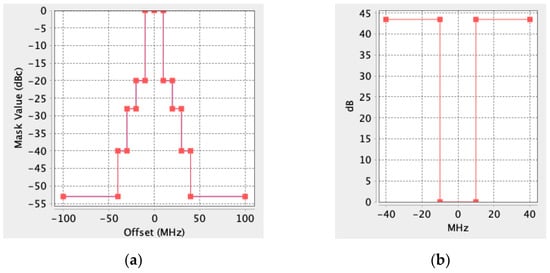
Figure 4.
Wi-Fi: (a) transmitter emission mask; and (b) receiver-blocking mask.

Figure 5.
Bluetooth: (a) transmitter emission mask; and (b) receiver-blocking mask.
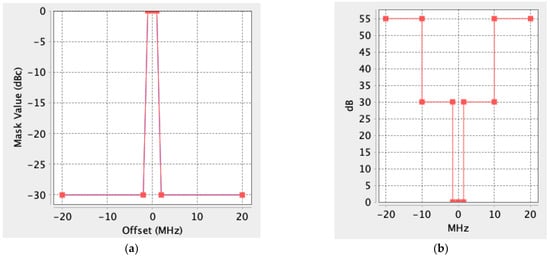
Figure 6.
WirelessHART: (a) transmitter emission mask; and (b) receiver-blocking mask.
The remaining technical specifications for all of the systems are presented in Table 1. The noise floor was −114 dBm for all systems. WirelessHART devices, because of their application, are commonly found outdoors, installed in pipeline pressure gauges, or attached to sensors for environmental metrology. As such, 50% of the devices are considered outdoor. Moreover, Wi-Fi users can use the service when working outdoors (30% of the cases).

Table 1.
Technical specifications of wireless systems (Wi-Fi, WirelessHART, and Bluetooth).
5. Simulation Planning
The simulation environment was a factory with a shop floor area of 40 m × 80 m and a total area of 80 m × 80 m (including external open spaces with vehicles, human activity, and wireless sensors), as depicted in Figure 7. This was an area of a typical medium-sized industrial environment. Each external wall had 5-dB attenuation [38].
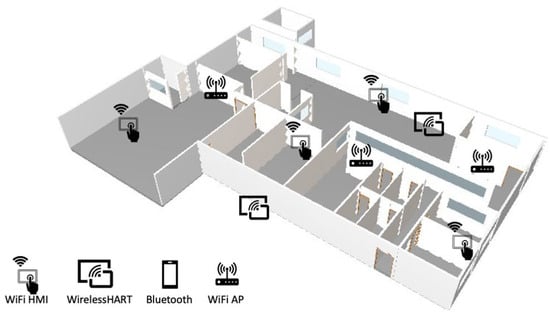
Figure 7.
Simulation environment with the description of the different wireless devices present on the factory shop floor and in the surrounding spaces.
Wi-Fi systems were divided into two subsystems relating to downlink (DL) and uplink (UL) because of the significant differences in the radio properties between the access point (AP) and the user equipment (UE). Each wireless system was sequentially considered the victim link and the interfering link for the other wireless systems, resulting in a total of 10 interference scenarios:
- Victim: WirelessHART–interferer: Bluetooth;
- Victim: WirelessHART–interferer: Wi-Fi DL;
- Victim: WirelessHART–interferer: Wi-Fi UL;
- Victim: Bluetooth–interferer: Wi-Fi DL;
- Victim: Bluetooth–interferer: Wi-Fi UL;
- Victim: Bluetooth–interferer: WirelessHART;
- Victim: Wi-Fi DL–interferer: Bluetooth;
- Victim: Wi-Fi DL– interferer: WirelessHART;
- Victim: Wi-Fi UL– interferer: WirelessHART;
- Victim: Wi-Fi UL–interferer: Bluetooth.
We considered that the self-system interference was duly managed by the radio resource management from the system control plane of each wireless system modeled and was not considered in this study, i.e., frequency-hopping techniques for Bluetooth and WirelessHART, and automatic channel assignment for Wi-Fi [39].
As shown in Figure 8a, representing the cumulative snapshot from one simulation scenario, the relative position between the wireless victim and interferer systems was uniformly distributed inside the factory shop floor and the surrounding area, simulating the mobility of the wireless devices. In this example, the victim link receiver, represented as a blue circle square, changed its position in each snapshot of the simulation and suffered interference from the interfering link transmitter (which also changed its position), represented as a red square. Thus, for each snapshot, the distance between the interfering source and the victim system receiver changed. This dynamic approach created a simulation scenario, where the relative position between wireless systems changed over time, and the interference results were closer to a typical scenario. Figure 8b,c show a snapshot of the unwanted and blocking emission levels, respectively, from an interfering system transmitter to a victim system receiver, as simulated with SEAMCAT.
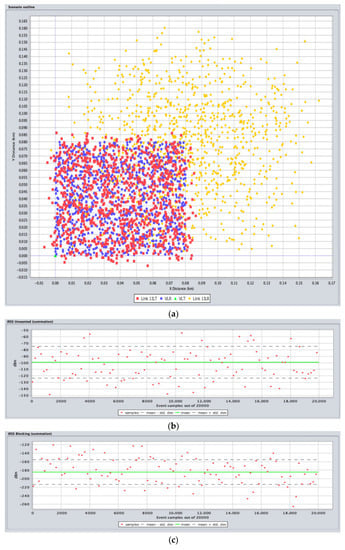
Figure 8.
Example of simulation for interference modeling with SEAMCAT: (a) a shop floor area with victim link and interfering link positions (VLT: Victim Link Transmitter; ILT: interfering link transmitter; VLR: victim link receiver; ILR: interfering link receiver); event samples of the sum of interfering transmissions of (b) unwanted emissions and (c) receiver blocking.
Moreover, the probability of transmission was discriminated between all of the wireless systems to follow the conditions of a real scenario:
- Wi-Fi: 70% [40];
- WirelessHART: 10% [41];
- Bluetooth: 5% [42].
All of the systems used the same ISM frequency band (2400–2483.5 MHz) for transmission and a frequency-hopping technique between all of the available channels. Wi-Fi uses channels 1, 6, and 11 (22 MHz bandwidth non-overlapping channels); Bluetooth uses 79 channels (1 MHz bandwidth each); and WirelessHART uses 16 channels (1 MHz bandwidth each). Thus, the study considered co-channel and adjacent channel interference cases.
For each identified scenario, the maximum likelihood of interference was set to 1%. As industrial applications use an ever-increasing number of AR/VR wireless devices to communicate, interference requirements had to be kept to a minimum to avoid communication failure or poor QoS, although other values could be used in conformity with the requirements of the wireless system application.
6. Simulation Results and Discussion
For each scenario, SEAMCAT ran twenty thousand (20,000) simulated events, or trials, following a Monte Carlo methodology whose main principle was to take samples of random variables from their probability density functions defined by the user and then use these samples to compute the probability of interference. For each event, the relative position of the interfering links and victim links were changed according to a uniform spatial distribution inside the factory shop floor and the surrounding areas. The I/N cumulative distribution function (CDF) values are shown in Figure 9 for all of the considered scenarios. Each point on the graph represented the probability that I/N was lower than the corresponding value on the horizontal axis. Values higher than the −6 dB threshold corresponded to excessive interference with the victim system. As can be seen from Figure 9a, the I/N criterion was mostly met when only 100 interferers/hectare (ha) were present, except for two scenarios: when Wi-Fi UL interfered over Bluetooth and when Wi-Fi DL interfered over WirelessHART systems, where the I/N criterion was exceeded by 26 dB. In the case of a density of 1000 interfering transmitters/ha, as shown in Figure 9b, the I/N criterion was exceeded for every deployment scenario and every type of interfering system. The results undoubtedly indicated that the use of the co-located license-exempt systems, even with frequency-hopping techniques to mitigate interference, might be challenging if the compatibility was assessed using the I/N criterion.
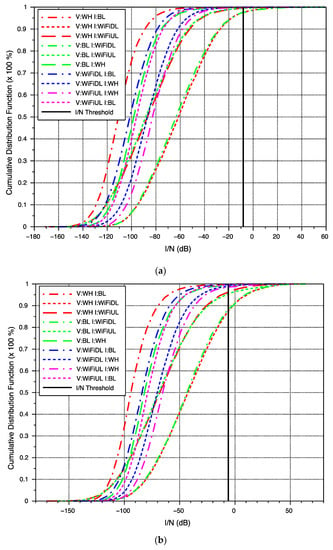
Figure 9.
CDF for all scenarios as a function of I/N: (a) 100 interfering transmitters/ha; and (b) 1000 interfering transmitters/ha. The black vertical line represents the interference criterion (I/N = −6 dB).
Figure 10 shows the C/I curve obtained for all of the 10 scenarios considered in this study. Each point on the graph represents the probability that C/I is higher than the corresponding value on the horizontal axis. Values lower than the 14-dB threshold corresponded to excessive interference to the victim system. From Figure 10a, we inferred that the C/I criterion was met in most trials. The results indicated that deploying legacy wireless systems in co-location scenarios when the density of interfering transmitters was at most 100/ha, allowed for compatibility in shared locations. However, when the density was increased to 1000 interfering transmitters/ha, the C/I criterion was exceeded for every scenario, from 3 dB to 45 dB, as shown in Figure 10b.
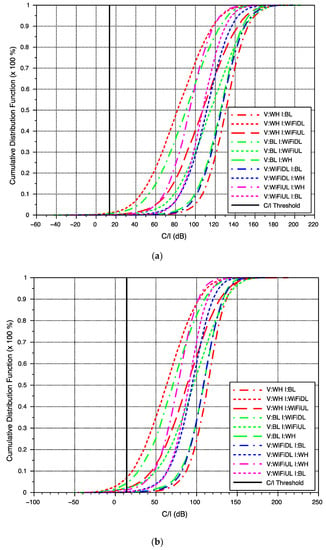
Figure 10.
CDF for 10 different scenarios as a function of C/I: (a) 100 interferer/ha; and (b) 1000 interferers/ha. The black vertical line represents the interference criterion (C/I = 14 dB).
According to the previous discussion, the results showed that the density of the interfering transmitters was an important parameter. Figure 11 shows the probability of interference as a function of the density of the interferers, from 1 to 1000 interfering transmitters/ha. The horizontal line represents the 1% probability of interference. As expected from the previous analysis, the results from C/I (Figure 11b) were more relaxed than those found with I/N (Figure 11a). Nevertheless, as the density of the interfering transmitters increased, so did the probability of interference. With I/N, the limit was reached for all of the scenarios when the density was higher than 500 interfering transmitters/ha, whereas, for C/I, the same limit was reached for almost all of the systems when the density was higher than 800 interfering transmitters/ha. An exception was made for WirelessHART and Bluetooth which did not reach the stipulated limit at this density.
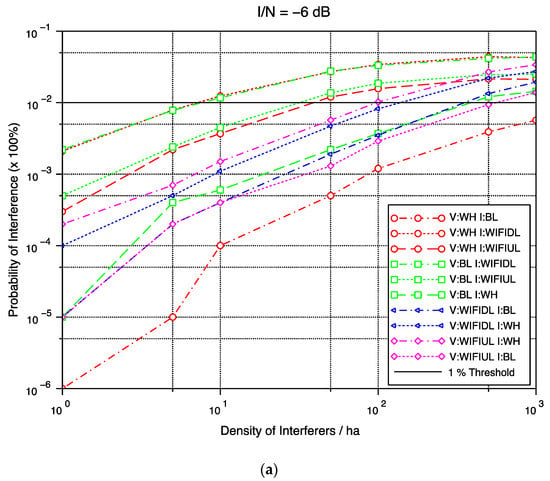
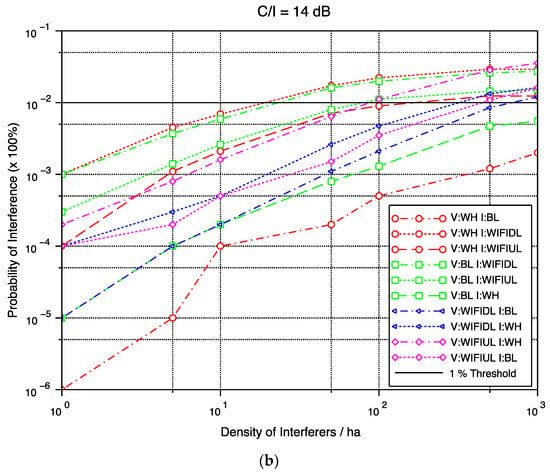
Figure 11.
Probability of interference for 10 different scenarios as a function of the density of the interfering transmitters: (a) I/N = −6 dB; and (b) C/I = 14 dB. The black horizontal line represents the limit of 1% probability of interference.
Taking into consideration the limits imposed for each scenario by the density of interfering transmitters, Table 2 shows the maximum density of interfering transmitter devices that could be deployed on the factory shop floor and in the surrounding area within an interference below the stipulated limit of 1%.

Table 2.
The maximum number of interferers on the factory shop floor for a 1% probability of interference.
As an example, consider the I/N criterion; in this case, the density of Bluetooth systems deployed could be as much as 400 transmitters/ha in the vicinity of WirelessHART systems, causing interference below the stipulated limit of 1%. This value could go higher than 1000 transmitters/ha if the C/I criterion was used. In contrast, Wi-Fi DL systems density should be restricted to less than 7 AP transmitters/ha (I/N criterion) or 11 AP transmitters/ha (C/I criterion), and for the Wi-Fi UL, up to 40 mobile devices/ha (I/N criterion) or 80 mobile devices/ha (C/I criterion), considering that both UL and DL were present in the same scenario to avoid exceeding the stipulated limit of 1% with the WirelessHART primary system.
The simulated results indicated that the compatibility between wireless systems operating in the ISM band depended on the selected protection criteria and interference limit. Traditionally, the I/N ratio has been used in many studies and may be considered a conservative approach. At the same time, the I/N criterion is rigorous and does not always emulate a real-case scenario. Given that some of the simulated systems have fixed locations (Wi-Fi access points or specific WirelessHART wireless sensors), it is possible to compute the desired signal with good accuracy. Hence, the use of the C/I criterion could allow a more realistic case. The C/I criterion largely depends on the properties of the signal. In this study, the C/I criterion was used for the highest-order modulation supported by Wi-Fi, Bluetooth, or WirelessHART systems, in the 2400–2483.5 MHz frequency band. For lower modulation orders, the C/I criterion would be lower than 14 dB, and consequently, the systems could be deployed with an even larger C/I margin.
Additionally, the results showed that AR/VR devices could coexist with other wireless devices using the same ISM band. However, the lack of coordination within the licensed-exempt wireless systems could be a serious problem with very high-density deployment. The aggregate interference levels could be reduced by using standard power-save protocols and by putting the radio transmitter in sleep or standby mode. These techniques are already available for wireless systems such as Wi-Fi and Bluetooth [43]. However, spending time moving in and out of sleep mode, or sending power-save polls increases latency and reduces throughput. Thus, the use of power-saving techniques in a wireless system supporting AR/VR wireless applications is not recommended.
Thus, the use of wireless devices in ISM bands for industrial applications might not satisfy the more demanding quality requirements, e.g., latency and reliability [44]. Therefore, the full potential of wireless technologies in industry has not yet been fully implemented with the unlicensed spectrum technology currently available.
The advent of 5G, the mobile network of the 5th generation, promises to overcome the shortcomings of legacy wireless systems using ISM bands [45]. Furthermore, 5G uses licensed frequency bands, so the noise level is lower and interference management is done centrally, i.e., the devices are mandated regarding which frequency they should use; this makes cellular networks very resilient [46].
7. Conclusions
In this study, SEAMCAT was used to evaluate radio interferences between Wi-Fi, Bluetooth, and WirelessHART communication systems for industrial use on the shop floor. Considering that wireless systems may soon become a standard for critical communications on the shop floor, spectrum compatibility studies are essential to evaluate their coexistence. These studies, expressed in terms of interference probability as a function of the I/N or C/I ratio are needed to evaluate, define, and validate conditions and rules under which new or evolved technologies, such as wireless systems, can access the spectrum. The results of the simulation revealed that from an electromagnetic point of view, interference levels differently affected the wireless radio receivers, and to some extent, might affect the system performance. This had an impact on network latency and, consequently, on the user experience (applications/devices), particularly that of devices that were more computing and memory intensive and with more demanding latency requirements, as might be the case with mobile AR/VR applications. The results also suggested that because they were often supported over Wi-Fi communications, a significant increase in mobile AR/VR applications in industrial environments might have an impact on other radio systems using the same frequency bands. Additionally, noise levels from machinery could cause even more interferences and might negatively impact AR/VR applications on mobile devices using the ISM frequency band. This will be a topic to be considered in further studies and simulations with SEAMCAT. Another open issue for future research is to evaluate the radio interferences considering the dynamic power control of the interfering devices and the effects on latency.
Nevertheless, the emerging 5G communication technologies [47] or the disruptive Wi-Fi 7 standard [48] will act as critical enablers for future mobile AR applications to achieve ultra-low-latency and extremely high data rates. This, along with substantial computer and storage resources placed at the edge of the Internet, near mobile devices, or sensors, has the potential to improve scalability, latency, and bandwidth over a cloud-based model.
Author Contributions
Conceptualization, R.D.; methodology, R.D.; software, R.D.; validation, R.D., F.R. and J.M.; formal analysis, R.D., F.R. and J.M.; investigation, R.D., F.R. and J.M.; writing—original draft preparation, R.D., F.R. and J.M.; writing—review and editing, R.D., F.R. and J.M. All authors have read and agreed to the published version of the manuscript.
Funding
This research received no external funding.
Data Availability Statement
The data presented in this study are available on request from the corresponding author.
Conflicts of Interest
The author declares no conflict of interest.
References
- Poor, R.; Hodges, B. Reliable Wireless Networks for Industrial Systems; Ember Corporation: Boston, MA, USA, 2002. [Google Scholar]
- Breitkreuz, D.; Müller, M.; Stegelmeyer, D.; Mishra, R. Augmented Reality Remote Maintenance in Industry: A Systematic Literature Review. Lect. Notes Comput. Sci. 2022, 13446, 287–305. [Google Scholar] [CrossRef]
- Mourtzis, D.; Siatras, V.; Angelopoulos, J. Real-time remote maintenance support based on augmented reality (AR). Appl. Sci. 2020, 10, 1855. [Google Scholar] [CrossRef]
- Venerella, J.; Franklin, T.; Sherpa, L.; Tang, H.; Zhu, Z. Integrating ar and vr for mobile remote collaboration. In Proceedings of the 2019 IEEE International Symposium on Mixed and Augmented Reality, ISMAR-Adjunct 2019, Beijing, China, 10–18 October 2019; pp. 104–108. [Google Scholar] [CrossRef]
- Piumsomboon, T.; Lee, Y.; Lee, G.; Billinghurst, M. CoVAR: A collaborative virtual and augmented reality system for remote collaboration. In Proceedings of the SIGGRAPH Asia 2017 Emerging Technologies, Bangkok, Thailand, 27–30 November 2017. [Google Scholar] [CrossRef]
- Chang, Y.-L.; Tien, C.-L. Development of mobile augmented-reality and virtual-reality simulated training systems for marine ecology education. In Proceedings of the Proceedings-Web3D 2019: 24th International ACM Conference on 3D Web Technology (2019), Los Angeles, CA USA, 26–28 July 2019. [Google Scholar] [CrossRef]
- Bacca, J.; Baldiris, S.; Fabregat, R.; Kinshuk Graf, S. Mobile Augmented Reality in Vocational Education and Training. Procedia Comput. Sci. 2015, 75, 49–58. [Google Scholar] [CrossRef]
- HMS Networks: 5G: Is the industry ready? Available online: https://www.hms-networks.com/technologies/5G/ready (accessed on 18 November 2022).
- Ehrlich, M.; Wisniewski, L.; Jasperneite, J. State of the Art and Future Applications of Industrial Wireless Sensor Networks. In Kommunikation und Bildverarbeitung in der Automation. Technologien für die intelligente Automation; Springer Vieweg: Berlin/Heidelberg, Germany, 2018. [Google Scholar] [CrossRef]
- Mennig, J.; Hajek, P.M.L. 5G in Industrial Production. Opportunities and Limitations. Available online: https://www.umlaut.com/en/stories/5g-in-industrial-production (accessed on 16 November 2022).
- Dionísio, R.; Lolić, T.; Torres, P. Electromagnetic Interference Analysis of Industrial IoT Networks: From Legacy Systems to 5G. In Proceedings of the 2020 IEEE Microwave Theory and Techniques in Wireless Communications (MTTW), Riga, Latvia, 1–2 October 2020; pp. 41–46. [Google Scholar] [CrossRef]
- CEPT; ECC. ECC Report 252. SEAMCAT Handbook, 2nd ed. 2016. Available online: https://docdb.cept.org/download/1270 (accessed on 12 December 2022).
- Dévendec, M.; Le Réfik, A. The spectrum engineering advanced Monte-Carlo analysis tool (SEAMCAT). In International Wrocław Symposium and Exhibition on Electromagnetic Compatibility; National Institute of Telecommunications: Wrocław, Poland, 2002; pp. 663–670. [Google Scholar]
- Qiao, X.; Ren, P.; Dustdar, S.; Liu, L.; Ma, H.; Chen, J. Web AR: A Promising Future for Mobile Augmented Reality—State of the Art, Challenges, and Insights. Proc. IEEE 2019, 107, 651–666. [Google Scholar] [CrossRef]
- Qiao, X.; Ren, P.; Nan, G.; Liu, L.; Dustdar, S.; Chen, J. Mobile web augmented reality in 5G and beyond: Challenges, opportunities, and future directions. China Commun. 2019, 16, 141–154. [Google Scholar] [CrossRef]
- Ruan, J.; Xie, D. Networked VR: State of the Art, Solutions, and Challenges. Electronics 2021, 10, 166. [Google Scholar] [CrossRef]
- Zhang, W.; Han, B.; Hui, P. On the Networking Challenges of Mobile Augmented Reality. In Proceedings of the Workshop on Virtual Reality and Augmented Reality Network. Association for Computing Machinery, New York, NY, USA, 25 August 2017; pp. 24–29. [Google Scholar] [CrossRef]
- Braud, T.; Bijarbooneh, F.H.; Chatzopoulos, D.; Hui, P. Future Networking Challenges: The Case of Mobile Augmented Reality. In Proceedings of the 2017 IEEE 37th International Conference on Distributed Computing Systems (ICDCS), Atlanta, GA, USA, 5–8 June 2017; pp. 1796–1807. [Google Scholar] [CrossRef]
- Hu, W.; Gao, Y.; Ha, K.; Wang, J.; Amos, B.; Chen, Z.; Pillai, P.; Satyanarayanan, M. Quantifying the Impact of Edge Computing on Mobile Applications. In Proceedings of the 7th ACM SIGOPS Asia-Pacific Workshop on Systems. Association for Computing Machinery, New York, NY, USA, 4–5 August 2016. [Google Scholar] [CrossRef]
- Sakal, I.; Simunic, D. Simulation of interference between Bluetooth and 802.11b systems. In Proceedings of the 2003 IEEE International Symposium on Electromagnetic Compatibility, 2003. EMC ’03, Istanbul, Turkey, 11–16 May 2003; Volume 2, pp. 1321–1324. [Google Scholar] [CrossRef]
- Rezha, F.P.; Shin, S.Y. Performance Analysis of ISA100.11a Under Interference From an IEEE 802.11b Wireless Network. IEEE Trans. Ind. Inform. 2014, 10, 919–927. [Google Scholar] [CrossRef]
- Yuan, W.; Wang, X.; Linnartz, J.-P.M.G.; Niemegeers, I.G.M.M. Coexistence Performance of IEEE 802.15.4 Wireless Sensor Networks Under IEEE 802.11b/g Interference. Wirel. Pers. Commun. 2013, 68, 281–302. [Google Scholar] [CrossRef]
- Silva, S.; Soares, S.; Fernandes, T.; Valente, A.; Moreira, A. Coexistence and interference tests on a Bluetooth Low Energy front-end. In Proceedings of the 2014 Science and Information Conference, Warsaw, Poland, 7–10 September 2014; pp. 1014–1018. [Google Scholar] [CrossRef]
- Baid, A.; Mathur, S.; Seskar, I.; Paul, S.; Das, A.; Raychaudhuri, D. Spectrum MRI: Towards diagnosis of multi-radio interference in the unlicensed band. In Proceedings of the 2011 IEEE Wireless Communications and Networking Conference, Roo, Mexico, 28–31 March 2011; pp. 534–539. [Google Scholar] [CrossRef]
- Mamadou Mamadou, A.; Toussaint, J.; Chalhoub, G. Survey on Wireless Networks Coexistence: Resource Sharing in the 5G Era. Mob. Networks Appl. 2020, 25, 1749–1764. [Google Scholar] [CrossRef]
- Kulkarni, V.; Sahoo, K.V.L.; Sahoo, S.K. A Survey on Interference Avoiding Methods for Wireless Sensor Networks Working in the 2.4 GHz Frequency Band. J. Eng. Sci. Technol. Rev. 2020, 13, 59–81. [Google Scholar] [CrossRef]
- Ahmadi, A.; Moradi, M.; Cherifi, C.; Cheutet, V.; Ouzrout, Y. Wireless Connectivity of CPS for Smart Manufacturing: A Survey. In Proceedings of the 2018 12th International Conference on Software, Knowledge, Information Management & Applications (SKIMA), Phnom Penh, Cambodia, 3–5 December 2018; pp. 1–8. [Google Scholar] [CrossRef]
- Weiner, M.; Jorgovanovic, M.; Sahai, A.; Nikolié. Design of a low-latency, high-reliability wireless communication system for control applications. In Proceedings of the 2014 IEEE International Conference on Communications (ICC), Sydney, Australia, 10–14 June 2014; pp. 3829–3835. [Google Scholar] [CrossRef]
- Hansell, P. Technical Support to Defence Spectrum. LTE into Wi-Fi Additional Analysis. 2014. Available online: https://www.ofcom.org.uk/__data/assets/pdf_file/0021/74613/lte_into_wi-fi_additional_analysis.pdf (accessed on 10 November 2022).
- ITU-R F.1094-2: Maximum allowable error performance and availability degradations to digital fixed wireless systems arising from radio interference from emissions and radiations from other sources (Rec. ITU-R F.1094-2). 2007. Available online: https://www.itu.int/rec/R-REC-F.1094/en (accessed on 10 November 2022).
- Winter, J.M.; Muller, I.; Pereira, C.E.; Savazzi, S.; Becker, L.B.; Netto, J.C. Coexistence issues in wireless networks for factory automation. In Proceedings of the 2014 12th IEEE International Conference on Industrial Informatics (INDIN), Porto Alegre, Brazil, 27–30 July 2014; pp. 370–375. [Google Scholar] [CrossRef]
- Dionisio, R.; Marques, P.; Rodriguez, J. Interference study between wireless microphone systems and TV White Space devices. In Proceedings of the 2012 IEEE International Conference on Communications (ICC), Ottawa, ON, Canada, 10–15 June 2012; pp. 1874–1878. [Google Scholar] [CrossRef]
- Zand, P.; Mathews, E.; Havinga, P.; Stojanovski, S.; Sisinni, E.; Ferrari, P. Implementation of WirelessHART in the NS-2 Simulator and Validation of Its Correctness. Sensors 2014, 14, 8633–8668. [Google Scholar] [CrossRef] [PubMed]
- Petersen, S.; Carlsen, S. Performance evaluation of WirelessHART for factory automation. In Proceedings of the 2009 IEEE Conference on Emerging Technologies & Factory Automation, Palma de Mallorca, Spain, 22–25 September 2009; pp. 1–9. [Google Scholar] [CrossRef]
- IEEE Std 802.11g-2003; IEEE Standard for Information Technology—Local and Metropolitan Area Networks—Specific Requirements—Part 11: Wireless LAN Medium Access Control (MAC) and Physical Layer (PHY) Specifications: Further Higher Data Rate Extension in the 2.4 GHz Band. IEEE: Piscataway, NJ, USA, 2003; pp. 1–104. Available online: https://ieeexplore.ieee.org/servlet/opac?punumber=8601 (accessed on 11 November 2022). [CrossRef]
- Bluetooth SIG: Bluetooth SIG-Special Interest Group. Radio Frequency Physical Layer (RFPHY). Core Specification 5.3. Available online: https://www.bluetooth.com/specifications/specs/core-specification-5-3/ (accessed on 12 December 2022).
- IEC: IEC 62591:2016, Industrial Networks-Wireless Communication Network and Communication Profiles-Wireless HART. Available online: https://webstore.iec.ch/publication/24433 (accessed on 12 December 2022).
- Nithya, V.; Chandran, B. Performance Analysis of IEEE 802.15.4 RF Zigbee Transceiver in an Indoor and Outdoor Environment. Indian J. Sci. Technol. 2016, 9, 1–9. [Google Scholar] [CrossRef]
- CISCO: Channel Management. Available online: https://www.cisco.com/assets/sol/sb/WAP561_Emulators/WAP561_Emulator_v1.0.4.4/help/Clustering5.html (accessed on 25 November 2022).
- Joseph, W.; Pareit, D.; Vermeeren, G.; Naudts, D.; Verloock, L.; Martens, L.; Moerman, I. Determination of the duty cycle of WLAN for realistic radio frequency electromagnetic field exposure assessment. Prog. Biophys. Mol. Biol. 2013, 111, 30–36. [Google Scholar] [CrossRef]
- Linear Technology: SmartMesh WirelessHART User’s Guide. 2015. Available online: https://www.analog.com/media/en/technical-documentation/user-guides/smartmesh_wirelesshart_user_s_guide.pdf (accessed on 10 November 2022).
- NXP: AN12595 FRDM-KW38 Co-Existence with RF System Evaluation Report for Bluetooth® Low Energy Application. Available online: https://www.nxp.com/docs/en/application-note/AN12595.pdf (accessed on 24 November 2022).
- Sidam, A.; Koutarapu, P.; Methuku, M.; Vuyyala, S. A Comparative Analysis on Benefits of Unscheduled Automatic Power Save Delivery Over Legacy Power Save Mode in IEEE 802 11 Wireless Networks. In Proceedings of the 2022 9th International Conference on Computing for Sustainable Global Development (INDIACom), New Delhi, India, 23–25 March 2022; pp. 551–555. [Google Scholar] [CrossRef]
- 5G Alliance for Connected Industries and Automation. 5G for Connected Industries and Automation. Available online: https://5g-acia.org/resources/whitepapers-deliverables/ (accessed on 18 November 2022).
- Ashraf, S.A.; Aktas, I.; Eriksson, E.; Helmersson, K.W.; Ansari, J. Ultra-reliable and low-latency communication for wireless factory automation: From LTE to 5G. In Proceedings of the 2016 IEEE 21st International Conference on Emerging Technologies and Factory Automation (ETFA), Berlin, Germany, 6–9 September 2016; pp. 1–8. [Google Scholar] [CrossRef]
- Ancans, G.; Bobrovs, V. Spectrum Usage for 5G Mobile Communication Systems and Electromagnetic Compatibility with Existent Technologies. In Broadband Communications Networks; Haidine, A., Aqqal, A., Eds.; IntechOpen: Rijeka, Croatia, 2017. [Google Scholar] [CrossRef]
- Siriwardhana, Y.; Porambage, P.; Liyanage, M.; Ylianttila, M. A Survey on Mobile Augmented Reality With 5G Mobile Edge Computing: Architectures, Applications, and Technical Aspects. IEEE Commun. Surv. Tutorials. 2021, 23, 1160–1192. [Google Scholar] [CrossRef]
- Chauhan, S.; Sharma, A.; Pandey, S.; Rao, K.N.; Kumar, P. IEEE 802.11be: A Review on Wi-Fi 7 Use Cases. In Proceedings of the 2021 9th International Conference on Reliability, Infocom Technologies and Optimization (Trends and Future Directions) (ICRITO), Noida, India, 3–4 September 2021; pp. 1–7. [Google Scholar] [CrossRef]
Disclaimer/Publisher’s Note: The statements, opinions and data contained in all publications are solely those of the individual author(s) and contributor(s) and not of MDPI and/or the editor(s). MDPI and/or the editor(s) disclaim responsibility for any injury to people or property resulting from any ideas, methods, instructions or products referred to in the content. |
© 2022 by the authors. Licensee MDPI, Basel, Switzerland. This article is an open access article distributed under the terms and conditions of the Creative Commons Attribution (CC BY) license (https://creativecommons.org/licenses/by/4.0/).